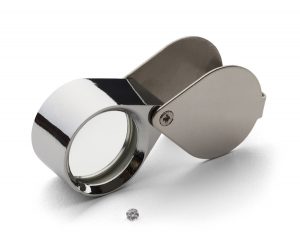Hand lenses are utilized in many industries including jewelry but they also serve the earth science fields as a great tool to view objects at a magnified scale, on site and without the bulkiness of other magnifying devices. A hand lens comprises of 2 parts, the first being the optics or lens and the other consisting of the body which holds the lens in place. They come in different materials with different features including magnification typically from 10x to 20x. In regards to earth science, they are utilized in everything from geology to sediment analysis and botany.
Let’s start by identifying two different material types of hand lenses. These tools can be made of either glass or plastic, with glass being the preferred choice of professionals due to the quality and durability. Plastic lenses are typically more affordable and lighter but may not offer the quality of magnification that a glass lens produces. Plastic lenses have also been proven to be more difficult to keep clean meaning the magnifier may not produce the quality image that a glass lens does. Lens diameter also plays a role in viewing and determines how wide the field of view is, helping to identify slightly larger details compared to a standard hand lens.
In order to use a hand lens, the correct technique begins by bringing the lens close to the eye while bringing the sample to be studied close to the lens. Please note that the word hand lens and loupe and interchangeable and refer to the same magnification tool. As you focus through the lens, slowly increase or decrease the distance from the subject being observed until a clear magnification image is produced. This will allow your sample to be magnified clearly and specific characteristics can be studied and documented on site.
Hand lenses are an effective tool for identifying numerous subjects in the field of study. That means keeping the loupe clean and safe by using a case and lanyard to ensure the hand lens is not dropped or scratched when not in use. Specific to earth science, horticulture can many times be an in-the-field study that thrives on viewing and documenting in real time so it is important that the lens is in good working condition so that details and identification is accurate and reliable.
A good lens maker may combine multiple pieces of glass in order to obtain the correct magnification needs of the user. There are three main types of lenses, those being triplets, coddington, and folding magnifiers.
- Triplets: These are made of 3 lenses and are typically considered the best as the light bends through multiple lenses creating a clear, magnified image. As different colors of light are bent through the lenses, the combination of 3 pieces of glass ensures that the light coming through is corrected to match the light coming out making the lens achromatic correct.
- Coddington lenses: These lenses are made of 2 pieces of glass working together to reduce the image and color distortions.
- Folding magnifiers: Folding magnifiers consist of multiples lenses that fold out of the unit and can be layered for different magnification levels. The downside of these magnifiers is that they distort color so what you see through the lens may differ from what you actually see with the naked eye outside of magnification.
All in all, hand lenses are an important tool allowing users of varying field and experience to view samples up close without having to return to a more sophisticated tool for identification. Remembering that a hand lens is a valuable tool and an investment that should last for many years with proper cleaning and care. Finally, don’t be fooled by the price of a hand lens. As with many things, you pay for what you get but there are some very quality and durable loupes that can be bought at reasonable prices. If your research and needs are identified before making the purchase you are more likely to find an affordable brand that meets your needs. For more custom lens information or design needs contact Universe Optics for a free custom quote.